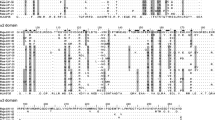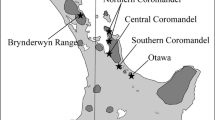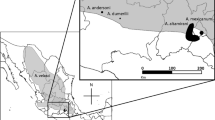Abstract
Major histocompatibility complex (MHC) genes encode proteins in the acquired immune response pathway that often show distinctive selection-driven patterns in wild vertebrate populations. We examined genetic variation and signatures of selection in the MHC class I alpha 1 (A1)- and alpha 2 (A2)-domain encoding exons of two frog congeners [Agalychnis callidryas (n = 20) and A. lemur (n = 20)] from a single locality in Panama. We also investigated how historical demographic processes may have impacted MHC genetic diversity by analyzing a neutral mitochondrial marker. We found that both MHC domains were highly variable in both species, with both species likely expressing three loci. Our analyses revealed different signatures of selection between the two species, most notably that the A. callidryas A2 domain had experienced positive selection while the A2 domain of A. lemur had not. Diversifying selection acted on the same number of A1 and A2 allelic lineages, but on a higher percentage of A1 sites compared to A2 sites. Neutrality tests of mitochondrial haplotypes predominately indicated that the two species were at genetic equilibrium when the samples were collected. In addition, two historical tests of demography indicated both species have had relatively stable population sizes over the past 100,000 years; thus large population size changes are unlikely to have greatly influenced MHC diversity in either species during this time period. In conclusion, our results suggest that the impact of selection on MHC diversity varied between these two closely related species, likely due to a combination of distinct ecological conditions and past pathogenic pressures.




Similar content being viewed by others
References
Acevedo-Whitehouse K, Cunningham AA (2006) Is MHC enough for understanding wildlife immunogenetics? Trends Ecol Evol 21:433–438
AmphibiaWeb. Agalychnis callidryas. http://amphibiaweb.org/. Accessed 15 July 2017
Anisimova M, Nielsen R, Yang Z (2003) Effect of recombination on the accuracy of the likelihood method for detecting positive selection at amino acid sites. Genetics 164:1229–1236
Apanius V, Penn D, Slev P, Ruff L (1997) The nature of selection on the major histocompatibility complex. Crit Rev Immunol 17:179–224
Barribeau SM, Villinger J, Waldman B (2008) Major histocompatibility complex based resistance to a common bacterial pathogen of amphibians. PLoS One 3:e2692
Bataille A, Cashins SD, Grogan L, Skerratt LF, Hunter D, McFadden M, Scheele B, Brannelly LA, Macris A, Harlow PS, Bell S, Berger L, Waldman B (2015) Susceptibility of amphibians to chytridiomycosis is associated with MHC Class II conformation. Proc R Soc B 282:20143127
Bernatchez L, Landry C (2003) MHC studies in nonmodel vertebrates: what have we learned about natural selection in 15 years? J Evol Biol 16:363–377
Bjorkman PJ, Saper MA, Samraoui B, Bennett WS, Strominger JL, Wiley DC (1987) Structure of the human class I histocompatibility antigen, HLA-A2. Nature 329:506–512
Bos DH, Waldman B (2006) Evolution by recombination and transspecies polymorphism in the MHC class I gene of Xenopus laevis. Mol Biol Evol 23:137–143
Brem FM, Lips KR (2008) Batrachochytrium dendrobatidis infection patterns among Panamanian amphibian species, habitats and elevations during epizootic and enzootic stages. Dis Aquat Organ 81:189–202
Crawford AJ, Lips KR, Bermingham E (2010) Epidemic disease decimates amphibian abundance, species diversity, and evolutionary history in the highlands of central Panama. Proc Natl Acad Sci USA 107:13777–13782
Didinger C, Eimes JA, Lillie M, Waldman B (2017) Multiple major histocompatibility complex class I genes in Asian anurans: ontogeny and phylogeny. Dev Comp Immunol 70:69–79
Doherty P, Zinkernagel R (1975) Enhanced immunological surveillance in mice heterozygous at the H-2 gene complex. Nature 256:50–52
Drummond AJ, Suchard MA, Xie D, Rambaut A (2012) Bayesian phylogenetics with BEAUti and the BEAST 1.7. Mol Biol Evol 29:1969–1973
Faivovich J, Haddad CFB, Baêta D, Jungfer K-H, Álvares GFR, Brandão RA, Sheil C, Barrientos LS, Barrio-Amoros CL, Cruz CAG, Wheeler WA (2010) The phylogenetic relationships of the charismatic poster frogs, Phyllomedusinae (Anura, Hylidae). Cladistics 26:227–261
Flajnik MF, Ohta Y, Greenberg AS, Salter-Cid L, Carrizosa A, Du Pasquier L, Kasahara M (1999) Two ancient allelic lineages at the single classical class I locus in the Xenopus MHC. J Immunol 163:3826–3833
Fu YX (1997) Statistical tests of neutrality of mutations against population growth, hitchhiking and background selection. Genetics 147:915–925
Fu YX, Li WH (1993) Statistical tests of neutrality of mutations. Genetics 133:693–709
Gong J, Sun Q-P, Xue F, Fang S-G, Wan Q-H (2013) Molecular characterization of the major histocompatibility complex class Ia gene in the black-spotted frog, Pelophylax nigromaculata. Biochem Genet 51:876–888
Hall TA (1999) BioEdit: a user friendly biological sequence alignment editor and analysis program for Windows95⁄97⁄NT. Nucleic Acids Symp Ser 41:95–98
Harf R, Sommer S (2005) Association between MHC class II DRB alleles and parasite load in the hairy-footed gerbil, Gerbillurus paeba, in the Southern Kalahari. Mol Ecol 14:85–91
Hauswaldt J, Stuckas H, Pfautsch S, Tiedemann R (2007) Molecular characterization of MHC class II in a nonmodel anuran species, the fire-bellied toad Bombina bombina. Immunogenetics 59:479–491
Höglund J, Wengström Å, Rogell B, Meyer-Lucht Y (2015) Low MHC vVariation in isolated island populations of the Natterjack Toad (Bufo calamita). Cons Genet 16:1007–1010
Hughes A, Hughes M (1995) Natural selection on the peptide-binding regions of major histocompatibility complex molecules. Immunogenetics 42:233–243
Hughes A, Yeager M (1998) Natural selection at major histocompatibility complex loci of vertebrates. Ann Rev Genet 32:415–434
Hughes AL, Hughes MK, Watkins DI (1993) Contrasting roles of interallelic recombination at the HLA-A and HLA-B loci. Genetics 133:669–680
Kaufman J, Salomonsen J, Flajnik M (1994) Evolutionary conservation of MHC class I and class II molecules—different yet the same. Semin Immunol 6:411–424
Kiemnec-Tyburczy KM, Richmond JQ, Savage AE, Lips KR, Zamudio KR (2012) Genetic diversity of MHC class I loci in six non-model frogs is shaped by positive selection and gene duplication. Heredity 109:146–155
Klein J (1986) Natural history of the major histocompatibility complex. Wiley, New York
Klein J (1987) Origin of major histocompatibility complex polymorphism: The trans-species hypothesis. Hum Immunol 19:155–162
Kloch A, Babik W, Bajer A, Siński E, Radwan J (2010) Effects of an MHC-DRB genotype and allele number on the load of gut parasites in the bank vole Myodes glareolus. Mol Ecol 19:255–265
Kobari F, Sato K, Shum BP, Tochinai S, Katagiri M, Ishibashi T, Pasquier L, Flajnik MF, Kasahara M (1995) Exon-intron organization of Xenopus MHC class II β chain genes. Immunogenetics 42:376–385
Kosch TA, Eimes JA, Didinger C, Brannelly LA, Waldman B, Berger L, Skerratt LF (2017) Characterization of MHC class IA in the endangered southern corroboree frog. Immunogenetics 69:165–174
Lau Q, Igawa T, Komaki S, Satta Y (2016) Characterisation of major histocompatibility complex class I genes in Japanese Ranidae frogs. Immunogenetics 68:797–806
Librado P, Rozas J (2009) DnaSP v5: A software for comprehensive analysis of DNA polymorphism data. Bioinformatics 25:1451–1452
Lillie M, Shine R, Belov K (2014) Characterisation of major histocompatibility complex class I in the Australian cane toad, Rhinella marina. PLoS One 8:e102824
Lips KR, Brem F, Brenes R, Reeve JD, Alford RA, Voyles J, Carey C, Livo L, Pessier AP, Collins JP (2006) Emerging infectious disease and the loss of biodiversity in a Neotropical amphibian community. Proc Natl Acad Sci USA 103:3165–3170
Lips KR, Diffendorfer J, Mendelson JR, Sears MW (2008) Riding the wave: reconciling the roles of disease and climate change in amphibian declines. PLoS Biol 6:e72
Macey JR, Schulte JA, Larson A, Fang Z, Wang Y, Tuniyev BS, Papenfuss TJ (1998) Phylogenetic relationships of toads in the Bufo bufo species group from the eastern escarpment of the Tibetan Plateau: a case of vicariance and dispersal. Mol Phylogenet Evol 9:80–87
May S, Beebee T (2009) Characterization of major histocompatibility complex class II alleles in the natterjack toad, Bufo calamita. Conserv Genet Resour 1:415–417
Murrell B, Wertheim JO, Moola S, Weighill T, Scheffler K, Kosakovsky Pond SL (2012) Detecting individual sites subject to episodic diversifying selection. PLoS Genet 8:e1002764
Nei M, Gu X, Sitnikova T (1997) Evolution by the birth-and-death process in multigene families of the vertebrate immune system. Proc Natl Acad Sci USA 94:7799–7806
Nielsen R, Bustamante C, Clark AG, Glanowski S, Sackton TB, Hubisz MJ, Fledel-Alon A, Tanenbaum DM, Civello D, White TJ, Sninsky J, Adams J, Cargill MD M (2005) A scan for positively selected genes in the genomes of humans and chimpanzees. PLoS Biol 3:e170
Ohta Y, Goetz W, Hossain MZ, Nonaka M, Flajnik MF (2006) Ancestral organization of the MHC revealed in the amphibian Xenopus. J Immunol 176:3674–3685
Pond SLK, Frost SDW (2005) Datamonkey: rapid detection of selective pressure on individual sites of codon alignments. Bioinformatics 21:2531–2533
Pond SLK, Posada D, Gravenor MB, Woelk CH, Frost SDW (2006) Automated phylogenetic detection of recombination using a genetic algorithm. Mol Biol Evol 23:1891–1901
Pond SLK, Murrell B, Fourment M, Frost SDW, Delport W, Scheffler K (2011) A random effects branch-site model for detecting episodic diversifying selection. Mol Biol Evol 28:3033–3043
Rambaut A, Suchard MA, Xie D, Drummond AJ (2014) Tracer v1.6. http://beast.bio.ed.ac.uk/Tracer. Accessed 23 May 2017
Ramos-Onsins SE, Rozas J (2000) Statistical properties of new neutrality tests against population growth. Mol Biol Evol 19:2092–2100
Robertson JM, Duryea MC, Zamudio KR (2009) Discordant patterns of evolutionary differentiation in two Neotropical treefrogs. Mol Ecol 18:1375–1395
Roelants K, Haas A, Bossuyt F (2011) Anuran radiations and the evolution of tadpole morphospace. Proc Natl Acad Sci USA 108:8731–8736
Savage JM (2002) The amphibians and reptiles of Costa Rica. University of Chicago Press, Chicago
Savage AE, Zamudio KR (2011) MHC genotypes associate with resistance to a frog-killing fungus. Proc Natl Acad Sci USA 108:16705–16710
Savage AE, Becker CG, Zamudio KZ (2015) Linking genetic and environmental factors in amphibian disease risk. Evol Appl 8:560–572
Scheffler K, Martin DP, Seoighe C (2006) Robust inference of positive selection from recombining coding sequences. Bioinformatics 22:2493–2499
Shum BP, Avila D, Du Pasquier L, Kasahara M, Flajnik MJ (1993) Isolation of a classical MHC class I cDNA from an amphibian. J Immunol 151:5376–5386
Smith KG, Lips KR, Chase J (2009) Epidemic disease homogenizes amphibian communities. Ecol Lett 12:1069–1078
Sommer S (2005) The importance of immune gene variability (MHC) in evolutionary ecology and conservation. Front Zool 2:16
Spurgin LG, Richardson DS (2010) How pathogens drive genetic diversity: MHC, mechanisms and misunderstandings. Proc Natl Acad Sci USA 277:979–988
Tajima F (1989) Statistical method for testing the neutral mutation hypothesis by DNA polymorphism. Genetics 123:585–595
Tamura K, Peterson D, Peterson N, Stecher G, Nei M, Kumar S (2011) MEGA5: Molecular Evolutionary Genetics Analysis using maximum likelihood, evolutionary distance, and maximum parsimony methods. Mol Biol Evol 28:2731–2739
Teacher AGF, Garner TWJ, Nichols RA (2009) Evidence for directional selection at a novel major histocompatibility class I marker in wild common frogs (Rana temporaria) exposed to a viral pathogen (ranavirus). PLoS One 4:e4616
Wallny H-J, Avila D, Hunt LG, Powell TJ, Riegert P, Salomonsen J, Skjødt K, Vainio O, Vilbois F, Wiles MV, Kaufman J (2006) Peptide motifs of the single dominantly expressed class I molecule explain the striking MHC-determined response to Rous sarcoma virus in chickens. Proc Natl Acad Sci USA 103:1434–1439
Whitfield SM, Geerdes E, Chacon I, Ballestero Rodriguez E, Jimenez RR, Donnelly MA, Kerby JL (2013) Infection and co-infection by the amphibian chytrid fungus and ranavirus in wild Costa Rican frogs. Dis Aquat Org 104:173–178
Wiens JJ, Fetzner JW, Parkinson CL, Reeder TW (2005) Hylid frog phylogeny and sampling strategies for speciose clades. Syst Biol 54:778–807
Zeisset I, Beebee TJC (2009) Molecular characterization of major histocompatibility complex class II alleles in the common frog, Rana temporaria. Mol Ecol Resour 9:738–745
Zeisset I, Beebee TJC (2014) Drift rather than selection dominates MHC class II allelic diversity patterns at the biogeographical range scale in natterjack toads Bufo calamita. PLoS One 9:e100176
Zhang W, Luo Z, Zhao M, Wu H (2015) High genetic diversity in the endangered and narrowly distributed amphibian species Vibrissaphora leishanensis. Integr Zool 10:465–481
Zhao M, Wang Y, Shen H, Li C, Chen C, Luo Z, Wu H (2013) Evolution by selection, recombination, and gene duplication in MHC class I genes of two Rhacophoridae species. BMC Evol Biol 13:1
Acknowledgements
We thank Anna Savage, Jonathan Richmond and Steve Bogdanowicz for technical assistance, and Jeanne Robertson for specimen collection. This work was supported by the National Science Foundation (Grants DEB-0815315, DEB-0717741 and DEB-1120249 to K.Z. and K.L.) and a Cornell Center for Comparative Population Genomics Fellowship (to K.K.-T).
Author information
Authors and Affiliations
Corresponding author
Ethics declarations
Conflict of interest
The authors declare no conflict of interest.
Ethical approval
All procedures performed in studies involving animals were in accordance with the ethical standards of the institution or practice at which the studies were conducted.
Electronic supplementary material
Below is the link to the electronic supplementary material.
Rights and permissions
About this article
Cite this article
Kiemnec-Tyburczy, K.M., Tracy, K.E., Lips, K.R. et al. Genetic variation and selection of MHC class I loci differ in two congeneric frogs. Genetica 146, 125–136 (2018). https://doi.org/10.1007/s10709-018-0016-0
Received:
Accepted:
Published:
Issue Date:
DOI: https://doi.org/10.1007/s10709-018-0016-0




